Arushi Goel
Music Flamingo: Scaling Music Understanding in Audio Language Models
Nov 13, 2025Abstract:We introduce Music Flamingo, a novel large audio-language model designed to advance music (including song) understanding in foundational audio models. While audio-language research has progressed rapidly, music remains challenging due to its dynamic, layered, and information-dense nature. Progress has been further limited by the difficulty of scaling open audio understanding models, primarily because of the scarcity of high-quality music data and annotations. As a result, prior models are restricted to producing short, high-level captions, answering only surface-level questions, and showing limited generalization across diverse musical cultures. To address these challenges, we curate MF-Skills, a large-scale dataset labeled through a multi-stage pipeline that yields rich captions and question-answer pairs covering harmony, structure, timbre, lyrics, and cultural context. We fine-tune an enhanced Audio Flamingo 3 backbone on MF-Skills and further strengthen multiple skills relevant to music understanding. To improve the model's reasoning abilities, we introduce a post-training recipe: we first cold-start with MF-Think, a novel chain-of-thought dataset grounded in music theory, followed by GRPO-based reinforcement learning with custom rewards. Music Flamingo achieves state-of-the-art results across 10+ benchmarks for music understanding and reasoning, establishing itself as a generalist and musically intelligent audio-language model. Beyond strong empirical results, Music Flamingo sets a new standard for advanced music understanding by demonstrating how models can move from surface-level recognition toward layered, human-like perception of songs. We believe this work provides both a benchmark and a foundation for the community to build the next generation of models that engage with music as meaningfully as humans do.
NVIDIA Nemotron Nano V2 VL
Nov 07, 2025Abstract:We introduce Nemotron Nano V2 VL, the latest model of the Nemotron vision-language series designed for strong real-world document understanding, long video comprehension, and reasoning tasks. Nemotron Nano V2 VL delivers significant improvements over our previous model, Llama-3.1-Nemotron-Nano-VL-8B, across all vision and text domains through major enhancements in model architecture, datasets, and training recipes. Nemotron Nano V2 VL builds on Nemotron Nano V2, a hybrid Mamba-Transformer LLM, and innovative token reduction techniques to achieve higher inference throughput in long document and video scenarios. We are releasing model checkpoints in BF16, FP8, and FP4 formats and sharing large parts of our datasets, recipes and training code.
Visually Interpretable Subtask Reasoning for Visual Question Answering
May 12, 2025



Abstract:Answering complex visual questions like `Which red furniture can be used for sitting?' requires multi-step reasoning, including object recognition, attribute filtering, and relational understanding. Recent work improves interpretability in multimodal large language models (MLLMs) by decomposing tasks into sub-task programs, but these methods are computationally expensive and less accurate due to poor adaptation to target data. To address this, we introduce VISTAR (Visually Interpretable Subtask-Aware Reasoning Model), a subtask-driven training framework that enhances both interpretability and reasoning by generating textual and visual explanations within MLLMs. Instead of relying on external models, VISTAR fine-tunes MLLMs to produce structured Subtask-of-Thought rationales (step-by-step reasoning sequences). Experiments on two benchmarks show that VISTAR consistently improves reasoning accuracy while maintaining interpretability. Our code and dataset will be available at https://github.com/ChengJade/VISTAR.
ETTA: Elucidating the Design Space of Text-to-Audio Models
Dec 26, 2024Abstract:Recent years have seen significant progress in Text-To-Audio (TTA) synthesis, enabling users to enrich their creative workflows with synthetic audio generated from natural language prompts. Despite this progress, the effects of data, model architecture, training objective functions, and sampling strategies on target benchmarks are not well understood. With the purpose of providing a holistic understanding of the design space of TTA models, we set up a large-scale empirical experiment focused on diffusion and flow matching models. Our contributions include: 1) AF-Synthetic, a large dataset of high quality synthetic captions obtained from an audio understanding model; 2) a systematic comparison of different architectural, training, and inference design choices for TTA models; 3) an analysis of sampling methods and their Pareto curves with respect to generation quality and inference speed. We leverage the knowledge obtained from this extensive analysis to propose our best model dubbed Elucidated Text-To-Audio (ETTA). When evaluated on AudioCaps and MusicCaps, ETTA provides improvements over the baselines trained on publicly available data, while being competitive with models trained on proprietary data. Finally, we show ETTA's improved ability to generate creative audio following complex and imaginative captions -- a task that is more challenging than current benchmarks.
OMCAT: Omni Context Aware Transformer
Oct 15, 2024



Abstract:Large Language Models (LLMs) have made significant strides in text generation and comprehension, with recent advancements extending into multimodal LLMs that integrate visual and audio inputs. However, these models continue to struggle with fine-grained, cross-modal temporal understanding, particularly when correlating events across audio and video streams. We address these challenges with two key contributions: a new dataset and model, called OCTAV and OMCAT respectively. OCTAV (Omni Context and Temporal Audio Video) is a novel dataset designed to capture event transitions across audio and video. Second, OMCAT (Omni Context Aware Transformer) is a powerful model that leverages RoTE (Rotary Time Embeddings), an innovative extension of RoPE, to enhance temporal grounding and computational efficiency in time-anchored tasks. Through a robust three-stage training pipeline-feature alignment, instruction tuning, and OCTAV-specific training-OMCAT excels in cross-modal temporal understanding. Our model demonstrates state-of-the-art performance on Audio-Visual Question Answering (AVQA) tasks and the OCTAV benchmark, showcasing significant gains in temporal reasoning and cross-modal alignment, as validated through comprehensive experiments and ablation studies. Our dataset and code will be made publicly available. The link to our demo page is https://om-cat.github.io.
Audio Dialogues: Dialogues dataset for audio and music understanding
Apr 11, 2024



Abstract:Existing datasets for audio understanding primarily focus on single-turn interactions (i.e. audio captioning, audio question answering) for describing audio in natural language, thus limiting understanding audio via interactive dialogue. To address this gap, we introduce Audio Dialogues: a multi-turn dialogue dataset containing 163.8k samples for general audio sounds and music. In addition to dialogues, Audio Dialogues also has question-answer pairs to understand and compare multiple input audios together. Audio Dialogues leverages a prompting-based approach and caption annotations from existing datasets to generate multi-turn dialogues using a Large Language Model (LLM). We evaluate existing audio-augmented large language models on our proposed dataset to demonstrate the complexity and applicability of Audio Dialogues. Our code for generating the dataset will be made publicly available. Detailed prompts and generated dialogues can be found on the demo website https://audiodialogues.github.io/.
Audio Flamingo: A Novel Audio Language Model with Few-Shot Learning and Dialogue Abilities
Feb 02, 2024



Abstract:Augmenting large language models (LLMs) to understand audio -- including non-speech sounds and non-verbal speech -- is critically important for diverse real-world applications of LLMs. In this paper, we propose Audio Flamingo, a novel audio language model with 1) strong audio understanding abilities, 2) the ability to quickly adapt to unseen tasks via in-context learning and retrieval, and 3) strong multi-turn dialogue abilities. We introduce a series of training techniques, architecture design, and data strategies to enhance our model with these abilities. Extensive evaluations across various audio understanding tasks confirm the efficacy of our method, setting new state-of-the-art benchmarks.
Language-guided Robot Grasping: CLIP-based Referring Grasp Synthesis in Clutter
Nov 09, 2023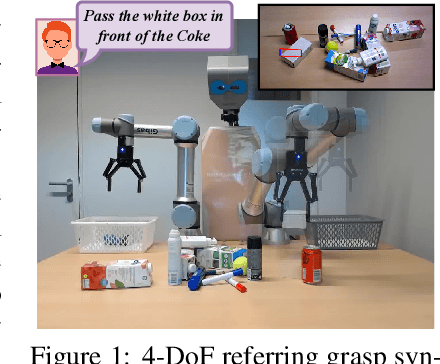
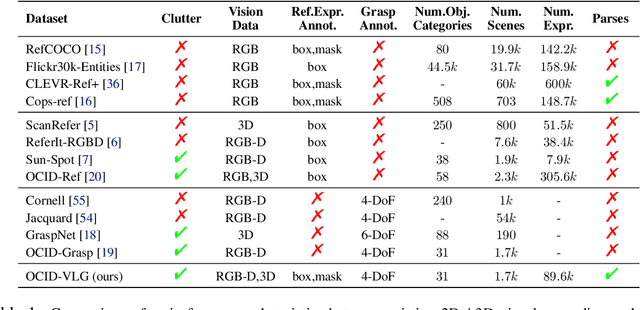
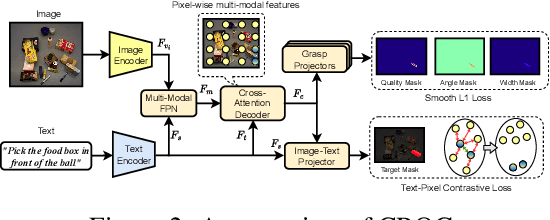
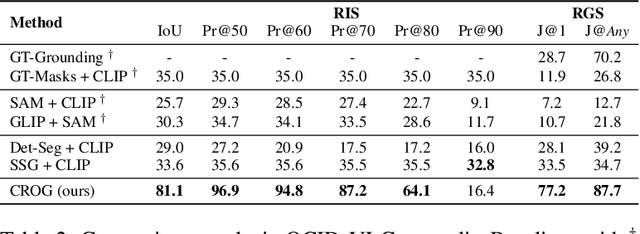
Abstract:Robots operating in human-centric environments require the integration of visual grounding and grasping capabilities to effectively manipulate objects based on user instructions. This work focuses on the task of referring grasp synthesis, which predicts a grasp pose for an object referred through natural language in cluttered scenes. Existing approaches often employ multi-stage pipelines that first segment the referred object and then propose a suitable grasp, and are evaluated in private datasets or simulators that do not capture the complexity of natural indoor scenes. To address these limitations, we develop a challenging benchmark based on cluttered indoor scenes from OCID dataset, for which we generate referring expressions and connect them with 4-DoF grasp poses. Further, we propose a novel end-to-end model (CROG) that leverages the visual grounding capabilities of CLIP to learn grasp synthesis directly from image-text pairs. Our results show that vanilla integration of CLIP with pretrained models transfers poorly in our challenging benchmark, while CROG achieves significant improvements both in terms of grounding and grasping. Extensive robot experiments in both simulation and hardware demonstrate the effectiveness of our approach in challenging interactive object grasping scenarios that include clutter.
Semi-supervised multimodal coreference resolution in image narrations
Oct 20, 2023
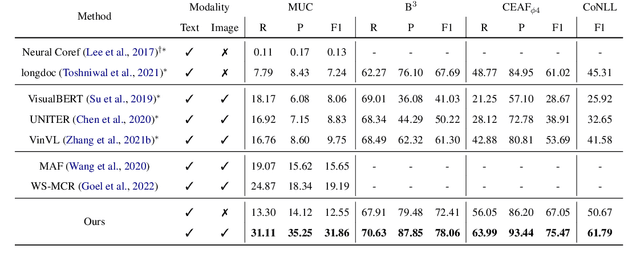
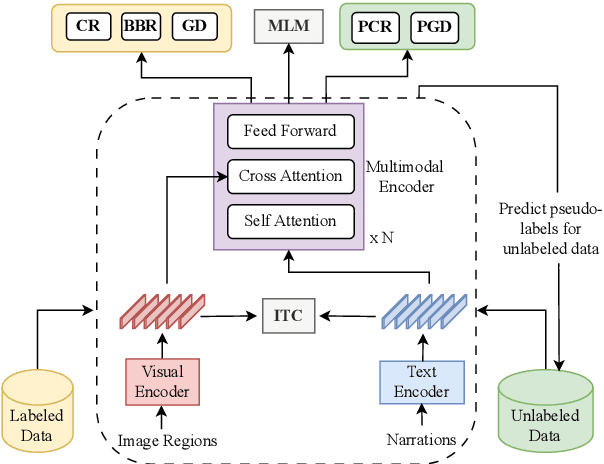
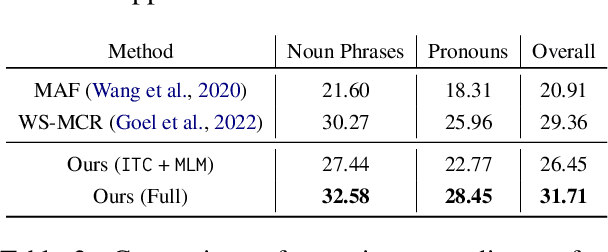
Abstract:In this paper, we study multimodal coreference resolution, specifically where a longer descriptive text, i.e., a narration is paired with an image. This poses significant challenges due to fine-grained image-text alignment, inherent ambiguity present in narrative language, and unavailability of large annotated training sets. To tackle these challenges, we present a data efficient semi-supervised approach that utilizes image-narration pairs to resolve coreferences and narrative grounding in a multimodal context. Our approach incorporates losses for both labeled and unlabeled data within a cross-modal framework. Our evaluation shows that the proposed approach outperforms strong baselines both quantitatively and qualitatively, for the tasks of coreference resolution and narrative grounding.
Encyclopedic VQA: Visual questions about detailed properties of fine-grained categories
Jun 15, 2023Abstract:We propose Encyclopedic-VQA, a large scale visual question answering (VQA) dataset featuring visual questions about detailed properties of fine-grained categories and instances. It contains 221k unique question+answer pairs each matched with (up to) 5 images, resulting in a total of 1M VQA samples. Moreover, our dataset comes with a controlled knowledge base derived from Wikipedia, marking the evidence to support each answer. Empirically, we show that our dataset poses a hard challenge for large vision+language models as they perform poorly on our dataset: PaLI [14] is state-of-the-art on OK-VQA [37], yet it only achieves 13.0% accuracy on our dataset. Moreover, we experimentally show that progress on answering our encyclopedic questions can be achieved by augmenting large models with a mechanism that retrieves relevant information from the knowledge base. An oracle experiment with perfect retrieval achieves 87.0% accuracy on the single-hop portion of our dataset, and an automatic retrieval-augmented prototype yields 48.8%. We believe that our dataset enables future research on retrieval-augmented vision+language models.
 Add to Chrome
Add to Chrome Add to Firefox
Add to Firefox Add to Edge
Add to Edge